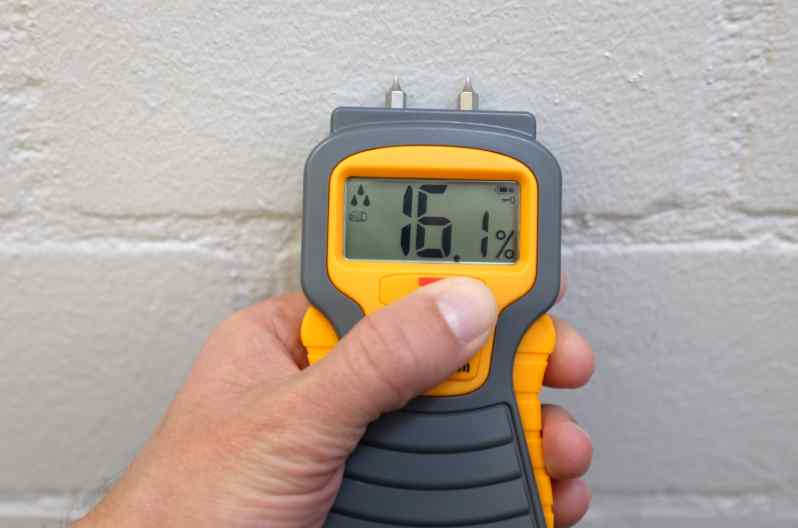Although it’s often overlooked, a moisture meter is an important tool when you are cleaning up water. Without a moisture meter, there is no way to tell when your home is actually dry. Even if walls or carpeting feel dry, they could still be wet inside. We explain how to use a moisture meter as well as how it works and where you can rent one if you have water damage.
What Is a Moisture Meter?
A moisture meter is a tool that measures the amount of water inside something. Restoration specialists use it to see how far the water spread as well as to check if your home is dry afterward.
Moisture meters measure electrical resistance and convert that into a moisture content percentage (%MC). Since water is a good conductor, electricity flows better when something is wet. The lower the resistance, the higher the moisture reading on the meter.
There are three types of meters:
- Pin-type moisture meters have two pins that you stick into items when testing. They are the most accurate, but they can damage your home. They are best for checking the moisture content after your home is dry.
- Pinless moisture meters have rounded tips for testing. However, they are less accurate because they only test the surface. Pinless meters are best for testing what areas are wet before you start drying.
- All-in-one moisture meters have both pins and rounded tips for testing. Since they can do both, they offer more flexibility and can test both before and after you dry your home.
In addition to testing the moisture content, some meters also include lights that indicate if the moisture levels are safe. Green indicates acceptable levels of moisture. Yellow meaning elevated levels. Red typically means severe moisture levels.
How To Read Your Meter
Most meters give a value between 0% and 100%. While you may think 0% means completely dry, that’s not entirely true. Everything in your home has a natural moisture content. Because of this, dry is a relative term.
For example, a dry wall will read between 0.2% and 0.8%. On the other hand, dry wood will read between 6% and 12% and carpet can read between 8% and 16%. For that reason, most meters include a scale for reference.
Where Can I Rent a Moisture Meter?
Although you can buy one, it’s best to rent a moisture meter unless you work in the restoration industry. You can buy a basic moisture meter for as low as $40 to $50, but a quality meter will cost anywhere from $150 to $1000 or more.
On the other hand, you can usually rent a moisture meter by the day for $25 to $40. Many places also offer weekly rates as low as $50 to $100.
The best reason to rent a moisture meter is that you can get a high-quality one for the same cost as an entry level model. And unless your home floods regularly, you might only use a meter once or twice in your whole life.
How To Use a Moisture Meter
1. Check How Far the Water Spread
The first thing you need to do is see how far the water spread. This way you have an idea of how much drying equipment you need.
Start in the center of the wet room and test every few inches until you get a consistent reading three times. Then move back to the spot where the reading increases and mark the spot. Continue until you’ve marked the entire room and know how much area you need to dry.
In addition to testing sideways, don’t forget to test up and down as well. Walls and cabinets can soak water up, causing damage inches or even feet above the floor.
2. Dry Your Home
Now that you have an idea of how much damage there is, you can dry out your home. In most cases, you’ll need two or three high volume fans and one structural drying dehumidifier for every 400 to 600 square feet.
You can start checking if areas are dry after four hours. Like you did before, test every surface until you get a consistent reading several times. As your home dries out, reposition fans to focus on areas that are still wet.
3. Test If Your Home Is Dry
If you are using the right equipment, you should be able to dry out your home in 12 to 24 hours. Continue checking every four hours until you get consistent results every time.
Whenever possible, you should use a pin-type meter to do your final tests. Check every surface that got wet, testing every one to two inches to make sure you don’t miss a wet spot. Make sure that you test side to side as well as up and down as well.
Also, remember that your carpet may read differently than your walls or cabinets. While your carpet doesn’t need to match your walls, all of your carpeting should read the same.
Knowing how to use a moisture meter is only one part of cleaning up water. It also takes the right tools and regular testing to dry your home fast. If you need help with water damage restoration, we are here to help. Our restoration specialists offer 24-hour emergency services and 30-minute response time to limit the damage. Call 1-888-443-3110 now for a free estimate on water cleanup and repairs.





